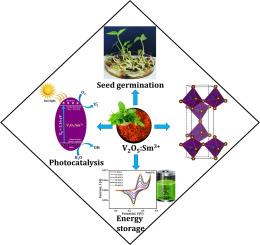Sustainable synthesis of V2O5:Sm3+ nanoparticles for malachite green photodegradation and high-efficiency supercapacitors
IF 6.3
3区 工程技术
Q1 ENGINEERING, CHEMICAL
Journal of the Taiwan Institute of Chemical Engineers
Pub Date : 2025-08-25
DOI:10.1016/j.jtice.2025.106341
引用次数: 0
Abstract
Background
The development of eco-friendly and efficient nanomaterials for environmental remediation and energy storage is crucial for sustainable technology. Vanadium pentoxide (V₂O₅) is a promising material due to its excellent optical, photocatalytic, and electrochemical properties. However, its performance can be further enhanced through strategic doping and green synthesis approaches.
Methods
A bio-fueled solution combustion method was used to synthesize undoped and samarium-doped V₂O₅ (V₂O₅:Sm³⁺) nanoparticles (NPs) utilizing Ocimum tenuiflorum leaf extract as a sustainable fuel. Structural, morphological, and optical properties were analyzed using XRD, FE-SEM, TEM, EDAX, XPS, and UV–Vis spectroscopy.
Significant findings
XRD confirmed orthorhombic V₂O₅ with Sm³⁺ substitution. FE-SEM and TEM showed a transition from nanosheets to hierarchical flower-like structures at higher doping levels. The bandgap narrowed from 2.72 eV to 2.16 eV, enhancing visible-light absorption. V₂O₅:9Sm³⁺ NPs exhibited 96.51 % photocatalytic degradation of Malachite Green within 100 min under sunlight and excellent recyclability. Phytotoxicity tests confirmed environmental safety, while electrochemical studies revealed superior supercapacitor performance with a high specific capacitance of 332.28 F/g and 93 % retention after 5000 cycles. The enhanced properties are attributed to Sm³⁺ induced structural and electronic modifications, demonstrating the potential of bio-synthesized V₂O₅:Sm³⁺ for sustainable applications.

孔雀石绿光降解高效超级电容器用V2O5:Sm3+纳米粒子的可持续合成
开发生态友好、高效的纳米材料用于环境修复和储能是可持续技术的关键。五氧化二钒(V₂O₅)因其优异的光学、光催化和电化学性能而成为一种有前途的材料。然而,它的性能可以通过战略掺杂和绿色合成的方法进一步提高。方法采用生物燃料溶液燃烧法合成未掺杂和掺钐的V₂O₅(V₂O₅:Sm³⁺)纳米粒子(NPs),利用竹叶提取物作为可持续燃料。采用XRD, FE-SEM, TEM, EDAX, XPS和UV-Vis光谱分析了其结构,形态和光学性质。重要发现:xrd证实了Sm³⁺取代正交V₂O₅。FE-SEM和TEM显示,在高掺杂水平下,纳米片结构向层次化的花状结构转变。带隙从2.72 eV缩小到2.16 eV,增强了可见光的吸收。V₂O₅:9Sm³⁺NPs在阳光下100分钟内对孔孔石绿的光催化降解率为96.51%,具有优异的可回收性。植物毒性测试证实了环境安全性,而电化学研究表明超级电容器的性能优越,比电容高达332.28 F/g,循环5000次后保持率为93%。增强的性能归因于Sm³⁺诱导的结构和电子修饰,证明了生物合成V₂O₅:Sm³⁺在可持续应用中的潜力。
本文章由计算机程序翻译,如有差异,请以英文原文为准。
求助全文
约1分钟内获得全文
求助全文
来源期刊
CiteScore
9.10
自引率
14.00%
发文量
362
审稿时长
35 days
期刊介绍:
Journal of the Taiwan Institute of Chemical Engineers (formerly known as Journal of the Chinese Institute of Chemical Engineers) publishes original works, from fundamental principles to practical applications, in the broad field of chemical engineering with special focus on three aspects: Chemical and Biomolecular Science and Technology, Energy and Environmental Science and Technology, and Materials Science and Technology. Authors should choose for their manuscript an appropriate aspect section and a few related classifications when submitting to the journal online.

 求助内容:
求助内容: 应助结果提醒方式:
应助结果提醒方式:


